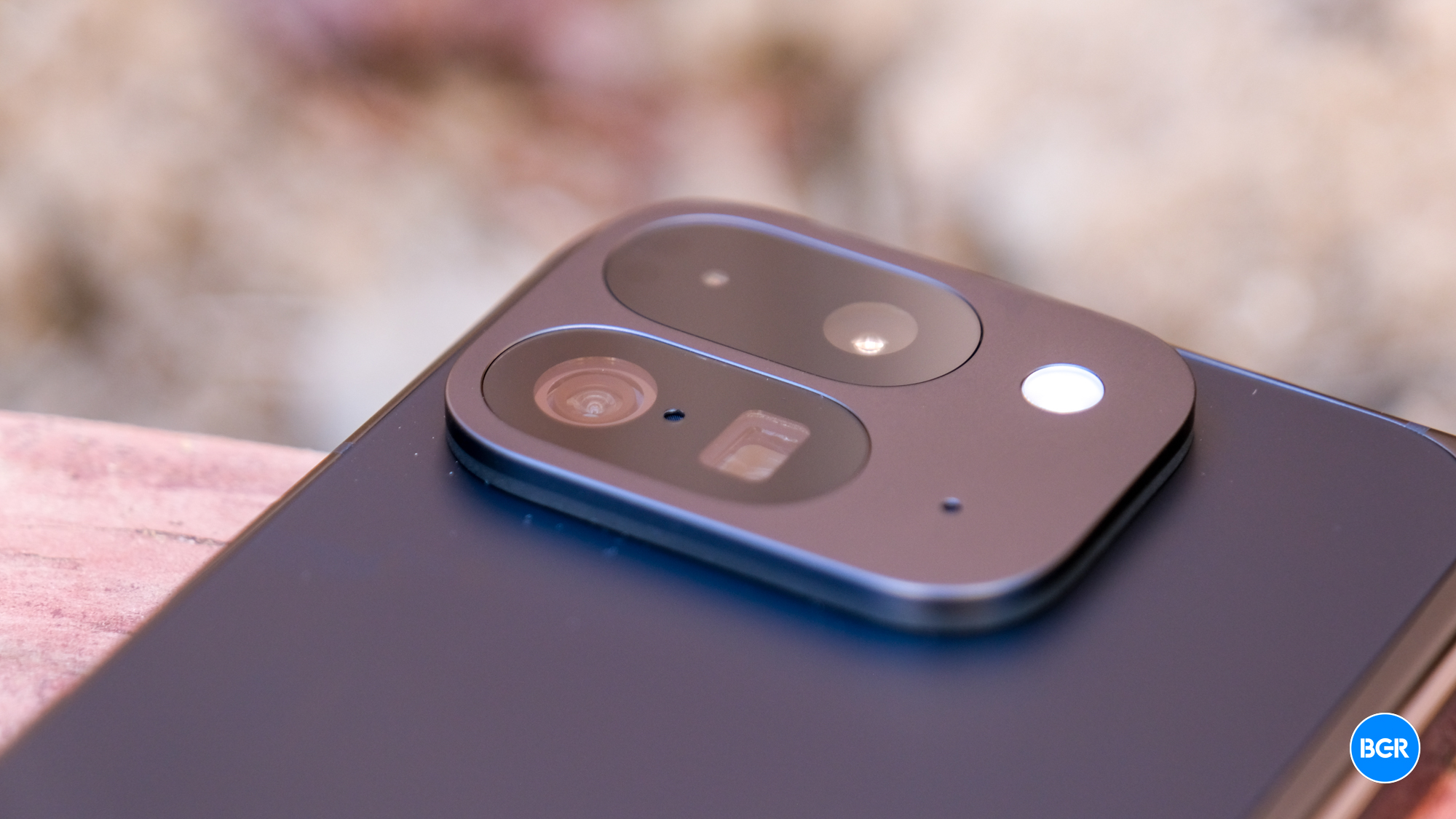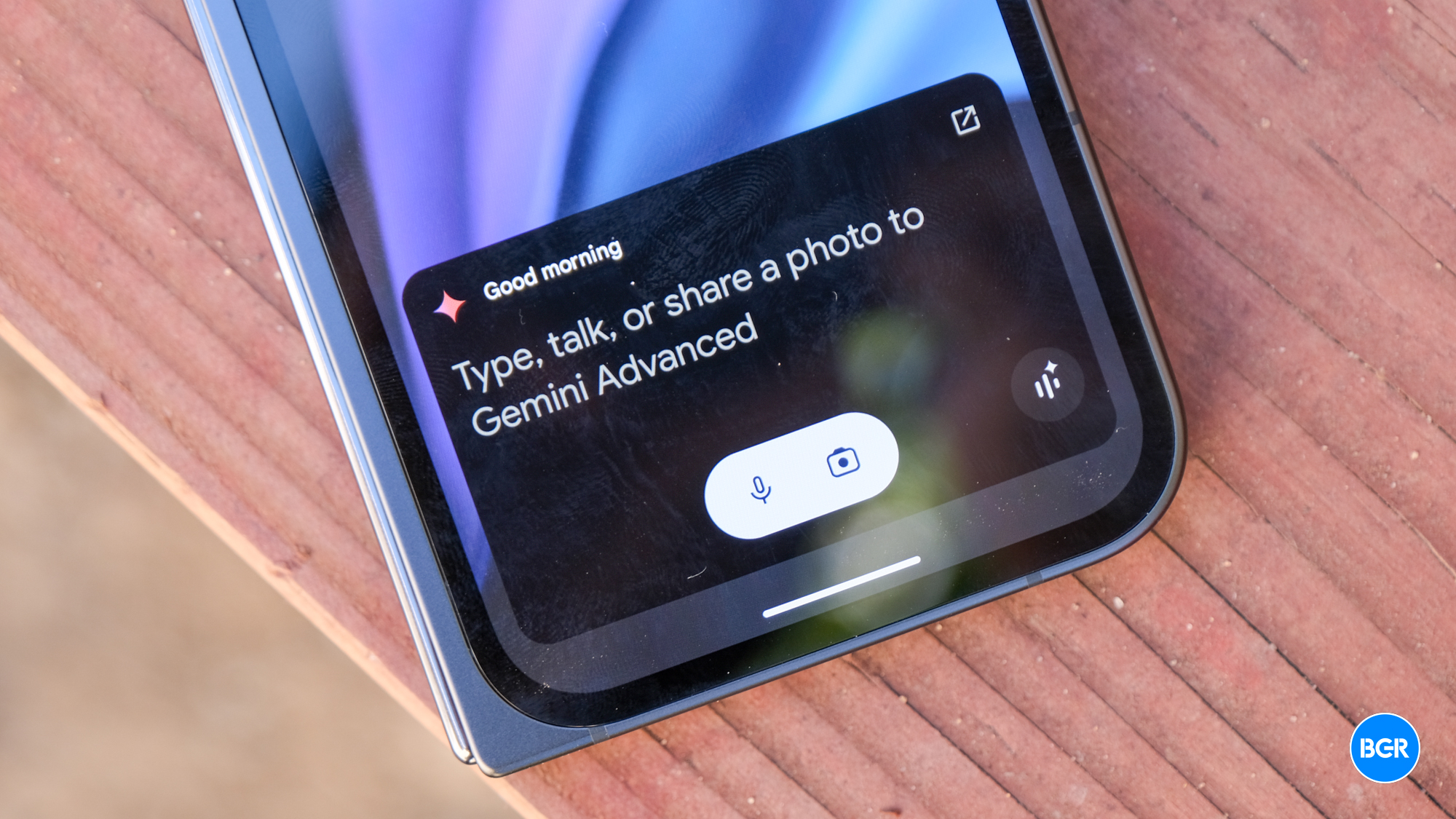Google Pixel 9 Pro Fold
The Google Pixel 9 Pro Fold gets a new form-factor and a new chipset, but is that enough to justify the price?
Pros
- Highly functional form-factor
- Performance is solid
- Camera quality is good
- Great software experience
- Thin build
Cons
- Camera, battery, and performance aren’t the best
- Expensive
| Buy From | List Price | Sale Price | |
|---|---|---|---|
| $1,799 | $1,799 | See It |
It seems as though Google is serious about foldable phones. The original Google Pixel Fold offered a passport-style foldable device that put Google’s approach to Android software front and center. It was my personal favorite foldable phone until OnePlus launched the OnePlus Open, which I preferred for its more usable form factor. But alongside the rest of the Pixel 9 series, the Google Pixel 9 Pro Fold adopts that taller form factor, making for a device that’s just as usable when folded up as any other slab phone. Unfold it, and you’ll get an impressive 8-inch display, making for a productivity machine.
But bizarrely, Google also didn’t go all the way with the Pixel 9 Pro Fold. The new device keeps largely the same camera setup as before, which isn’t a bad thing, but it makes the much more expensive device less impressive in photography than other Pixel 9 Pro devices.
Is form factor enough to make the Pixel 9 Pro Fold the foldable phone to beat? And is this update really only about the form factor to begin with? I’ve been using the Google Pixel 9 Pro Fold for a while now to find out.
Google Pixel 9 Pro Fold specs
| Dimensions | Folded: 155.2 x 77.1 x 10.5mmUnfolded: 155.2 x 150.2 x 5.1mm |
| IP rating | IPX8 |
| Display resolution | Cover: 1080 x 2424 pixelsInterior: 2076 x 2152 pixels |
| Display size | Cover: 6.3 inchesInterior: 8.0 inches |
| Display type | LTPO OLED |
| Display refresh rate | 120Hz |
| Display brightness | Cover: 2700 nits peakInterior: 2700 nits peak |
| Chipset | Google Tensor G4 |
| Memory | 16GB |
| Storage | 256GB, 512GB |
| Rear cameras | Wide: 48MP, f/1.7, OISTelephoto: 10.8MP, f/3.1, 5x optical zoomUltrawide: 10.5MP, f/2.2, 127-degrees |
| Video | 4K at 60fps, 1080p at 240fps |
| Front cameras | Cover: 10MP, f/2.2Interior: 8MP f/2.2 |
| Ports | USB-C 3.2 |
| Battery size | 4,650mAh |
| Charging | 21W wired, 7.5W wireless |
| Connectivity | Bluetooth 5.3, Wi-Fi 7, 5G |
| Colors | Porcelain, Obsidian |
| Price | $1,799 |
A design that’s built for versatility
The design of the Google Pixel 9 Pro Fold is a big step up over the original Pixel Fold. That’s not to say that the original device was poorly designed. On the contrary, it looked and felt quite nice. But Google has stepped up the build quality and design of its Pixel series in general with the Pixel 9, and the Pixel 9 Pro Fold is no exception to that rule.
The headline change here is in the shape of the device. While the original Pixel Fold was a passport-sized foldable phone, the Pixel 9 Pro Fold stretches to be taller. The result is that on the front, you get a larger 6.3-inch display with a 20:9 aspect ratio. For those keeping track, that’s the same size and aspect ratio of the display on the Pixel 9 and Pixel 9 Pro, and the result is that when using the phone folded up, it feels largely like a normal smartphone. I really appreciate this change. It makes the Pixel 9 Pro Fold feel a little closer to the OnePlus Open, which was my ideal foldable form factor, and it means that when you do unfold the device, you’ll get an even larger screen that sits in at a hefty 8 inches.

It’s not quite as premium-feeling as the other Pixel 9 devices, though. It does have the same aluminum frame along with a Gorilla Glass Victus II back. And it’s the matte glass that I really appreciated on the other phones. But something about it feels just a little less solid.
Part of that could be related to how thin the device is, which, of course, is a good thing. Google is quick to point out that it’s the thinnest foldable phone out there, but the fine print of that claim is that it’s only the thinnest foldable phone available in the US. The Honor Magic V3 is thinner than the Pixel 9 Pro Fold. That said, the Pixel 9 Pro Fold is still incredibly thin, and it feels like it in the hand. When folded up, the device is only slightly thicker than a phone like the iPhone 15 Pro Max, and it certainly doesn’t feel out of place in my pocket, given its thickness and weight.
Other aspects of the design are more or less to be expected. On the bottom of the right side of the device, there’s a USB-C port, while there’s a volume rocker and power button on the right-hand edge. The cover display has a hole-punch cutout for the front-facing camera in the center, while the interior screen’s front-facing camera is in the top right-hand corner.

I found the hinge to feel strong and easy to use too. The phone easily unfolded when I wanted it to, though I did have to use two hands for this. The hinge generally felt pretty similar to the original Pixel Fold, but that wasn’t a bad thing. And the hinge was strong enough to hold the phone at different angles. While there are limits to the angles to which it can be unfolded, I found that most normal use cases worked perfectly fine.
There is one aspect of the design that I didn’t love, though, and that’s the camera module. Inexplicably, Google has done away with the camera bar made famous by Pixel phones over the past three or four years in favor of a standard, boring, rectangular camera module on the back of the device. The result is that the original Pixel Fold looks more like a part of the Pixel 9 series than the new Pixel 9 Pro Fold does. I wish Google didn’t make this change, but in the grand scheme of things, it’s not a huge issue.
Generally speaking, the overall design of the Google Pixel 9 Pro Fold might well be my favorite foldable phone design so far. The OnePlus Open is a close second, and I generally did find that the build quality of the Open was slightly better. However, the thinner body of the Pixel 9 Pro Fold helps quite a bit, and it makes the phone feel lighter and more natural when it’s in your pocket.
Good displays that could be (slightly) better
The cover display on the Pixel 9 Pro Fold may be the same size as the Pixel 9 and Pixel 9 Pro, but its specifications more closely align with the standard Pixel 9. In other words, it has a 1080p resolution, and it is not an LTPO OLED screen — so it can only range from 60Hz to 120Hz, and not all the way down to 1Hz. Considering the price of this phone, I would have liked the cover display to be a little bit higher-tech and more closely aligned with the Pixel 9 Pro than the standard Pixel 9.
That said, the cover screen on the device certainly doesn’t look bad. It’s crisp enough for text to look detailed and images to look clear. And given the fact that it can range up to 120Hz, it felt smooth. It also gets relatively bright at 2,700 nits peak brightness, and I found that it was easily bright enough to be visible in outdoor settings.

And I suppose cutting costs in the cover display does make sense, given the fact that when display quality really matters, you’re likely to unfold the phone anyway. Thankfully, the interior screen delivers. It is an LTPO OLED screen, so it can range from 1Hz to 120Hz. That said, while its resolution is obviously higher, its pixel density is lower than the cover screen, so it’s slightly less crisp. You won’t really notice it in day-to-day use, and again, text still looked great, even small text that might be harder to read on lower-resolution screens. Like the cover display, the interior screen supports a peak brightness of 2,700 nits, and again, it was easily bright enough for use outdoors in direct sunlight.
Did Google make some compromises when it comes to the screen? Sure, but they’re minor ones, and generally speaking, the displays on the phone look great.
Performance that doesn’t quite compete…but that’s okay
Like the other Pixel 9 phones, the Google Pixel 9 Pro Fold makes use of the new Google Tensor G4 processor, and here it’s coupled with 16GB of RAM and either 256GB or 512GB of storage. Google has been criticized for its use of Tensor chips, largely due to the fact that they don’t quite perform as well as the best Qualcomm or Apple chips when it comes to basic performance. That continues here. Technically, the phone won’t perform quite as well as its similarly priced cousins from OnePlus and Samsung. But to be fair, I barely noticed it.
To be clear, I put the phone through its paces too. Whether through heavy multitasking or mobile gaming, the phone didn’t stutter or crash at all, and I certainly didn’t notice a big shift in performance when moving between the Pixel 9 Pro Fold and the best devices from Apple and Samsung. That’s not to say there isn’t a difference in performance, and generally speaking, performance plays a bigger role towards the end of a flagship phone’s lifespan than at the beginning.
But despite what some headlines might have you believe, the Pixel 9 Pro Fold is still an excellent-performing phone.
A battery that’ll get you through the day

The Google Pixel 9 Pro Fold is powered by a 4,650 mAh battery, and I found that the device didn’t necessarily offer the best battery life. To be clear, it did get me through a full day of use without exception, but you won’t be able to stretch it much beyond that if you’re a medium or heavy user. You’ll need to get into the routine of charging your phone at night if you’re not already in that routine. Of course, much of the battery life depends on how you use the phone, but if you rely mostly on the cover screen and only open the phone for certain tasks, then you may find that it performs a little better. But generally, there’s a trade-off to building such a thin phone, and often that comes in the form of battery life.
The Pixel 9 Pro Fold supports 21W wired charging, though you’ll need the right charger to achieve those speeds. It also supports wireless charging, though wireless charging maxes out at 7.5W, unlike the other Pixel 9 phones that can achieve a faster speed with the Pixel Stand. I’m disappointed that the entire Pixel 9 lineup doesn’t support Qi2, but hopefully, the Pixel 10 lineup will support the new wireless charging standard.
A high-end camera, but is it “Pro?”
The camera kind of continues the trend of being good, but not the best. The Pixel 9 Pro Fold has a triple camera array, made up of a 48-megapixel main camera, a 10.8-megapixel telephoto camera with 5x optical zoom, and a 10.5-megapixel ultrawide camera with a 127-degree field of view.

So why aren’t these the best cameras? Well, the camera system is more or less the same as the aging original Pixel Fold — and simply doesn’t reach the quality of the other “Pro”-branded Pixel 9 devices, like the Pixel 9 Pro. The telephoto camera makes the Pixel 9 Pro Fold’s camera more versatile than the standard Pixel 9, but I really would have liked to see a camera system as impressive as the Pixel 9 Pro.
That said, the camera on the Pixel 9 Pro Fold still isn’t bad by any means. It’s just not as impressive as it could be. In well-lit environments, the camera was still able to capture great-looking images, with plenty of detail and vibrancy. In low-light environments, the camera offered solid images, too, most of the time. It was relatively easy to push the camera to its limits by zooming in poor lighting, for example, but I think most will find the camera system to be great.
Images look like Pixel shots too. That’s not a bad thing — Google has long made contrast-heavy shots with good dynamic range, and that continues with the Pixel 9 Pro Fold.
Of course, it wouldn’t be a Pixel launch without new camera tricks. There are quite a few of them here, and they work quite well. For starters, there’s the new panorama mode, which walks you through essentially taking a series of standalone photos, after which the device will stitch them together, It works better than previous panorama mode, and makes for more detailed shots overall. It also means that Google can create better low-light panorama shots. Indeed, they look stunning.
Perhaps the headline new AI camera trick is the new Add Me feature. The concept is simple — instead of asking a stranger to take a group shot of you and your friends, take one without you, and then have a friend take one without them. The phone will combine the images into a group shot with everyone. It’s not perfect — sometimes it struggles with shadows, for example. But it does work pretty well and will likely get better.
And, of course, there are the camera features afforded by the foldable form-factor. For example, you can easily take selfies with the higher-quality rear-facing camera — and you’ll get much better results if you do so. The phone does have a front-facing camera in both displays, and while the quality is fine, you can tell the difference. You might be better off sticking with using the front-facing cameras for video calls.
AI tricks and software updates
Long gone are the days of the Pixel series being considered “stock Android.” These days, Pixel phones put Google’s services front-and-center — which isn’t a bad thing if you’re plugged into Google’s ecosystem.
The Pixel 9 Pro Fold ships with Android 14, with all the Pixel-focused features on top of it. This year, the theme of those features is decidedly “AI,” but thankfully, the software in generally still looks and feels great.
The AI features are immediately apparent, though, both in the form of additional apps and changes to your digital assistant.
For starters, there’s a new Call Notes feature, which records your phone call (after alerting all participants) and puts together notes on the call for your reference. The feature is pretty neat and can help ensure that you get all the details on those long chats with your health insurance company.
There’s also a new Screenshots feature. This feature perhaps should have been built into the Photos app, but the idea is that you can take all the screenshots you want, then use AI to easily search through them and find information from them down the line. It’s a neat idea, but as someone who doesn’t really take screenshots in that way, I’m not a huge fan of the extra app.

Next up is the Pixel Studio feature, which really worked very well. Pixel Studio is basically an image generation tool, which allows you to type in prompts for images for the device to generate. The fun part comes after that, though — as the service allows you to tweak the image as needed, add text, and more. It really works well, and could well see you cancel that Canva account.
Of course, perhaps the biggest AI change comes in the form of updates to Gemini, which is now the default digital assistant on Pixel phones. Gemini gets a new way of interacting — in the form of Gemini Live, which is a feature of Gemini Advanced. You get a year of Gemini Advanced with the Pixel 9 Pro Fold, which is nice.
Gemini Live is essentially a conversational chatbot, and it works very well. It’s actually kind of eerie conversing with an AI assistant in this way, after years of being told that my phone can’t help me because of a weak internet connection. It understood me extremely well and easily found the information I needed when I needed it. It did sometimes need some prompting to search the web for information — for example, it didn’t know about the existence of the “Pixel 9 Pro Fold” until I questioned its information and it searched the web. But it really did feel conversational, if only a little formal.
You may or may not care about all the new AI features, of course. What you likely will care about is the fact that Google says the Pixel 9 Pro Fold will get an impressive seven years of software updates. That’s pretty huge, and while we’ll have to wait and see if it actually happens, it’s a step in the right direction for the Android ecosystem.
Conclusions
Apparently, the Google Pixel 9 Pro Fold is a magical phone. Why? Well, despite the fact that it should offer a better camera system, better battery life, and better performance, it’s charmed me enough to be my new favorite foldable phone. Technically, it’s not as good as the OnePlus Open, which performs better and has a higher-end camera system, not to mention the longer battery life. But there’s something about the combination of Pixel software, helpful new AI features, and the slim new design that makes me keep reaching for the device on my desk.
That certainly doesn’t take away from those issues, though. Google is going to continue being criticized for performance until it can build a truly flagship-tier processor. And given the company’s experience in smartphone cameras, it’s a real shame that it didn’t include the best of those cameras in its most expensive Pixel. I can look past those issues on the Pixel 9 Pro Fold. Whether you can or not will come down to personal preference.
The competition
There are two main competitors to the Pixel Fold, in the form of the OnePlus Open and the Samsung Galaxy Z Fold 6.
On paper, the OnePlus Open is better than the Pixel 9 Pro Fold. The OnePlus Open performs better and has a better camera system, along with a longer-lasting battery. You’ll likely find it for a lower price too, which helps.
The same is true for the Samsung Galaxy Z Fold 6, which has the latest Qualcomm chip and also offers a longer-lasting battery. I prefer the form factor of the OnePlus Open and the Pixel 9 Pro Fold to the Galaxy Z Fold 6, but your opinion may differ. I will say that the build quality of the Galaxy Z Fold 6 is also stellar. Samsung has spent years refining this form factor, and it shows.
Neither the OnePlus Open nor the Galaxy Z Fold 6 offers the same software experience as the Pixel 9 Pro Fold. The OnePlus Open does have more helpful multitasking features, but Google Pixel software just fits my preference. You really can’t go wrong with any of these three phones, but given the choice, I would go for the Pixel 9 Pro Fold.
Should I buy the Google Pixel 9 Pro Fold?
Yes. It should be a better phone, but even as it is now, it’s an excellent foldable device.


















